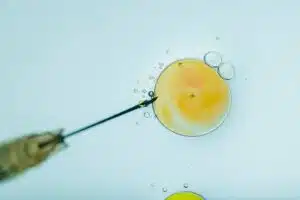Adoptions From The Heart is proud to offer Heartbeats, an Assisted Reproduction program designed to counsel families, help them determine which form of assisted reproduction is best for their future and educate on other options, like adoption, which may, in some cases, be a better fit.
In this guide, we’ll discover how in vitro fertilization (IVF), the most common form of Assisted Reproductive Technology, works. Then, we’ll provide a few questions for you to answer that may help you consider your ART options in more depth.
How Does In Vitro Fertilization Work?
 According to the Society for Assisted Reproductive Technology, 99% of families built through ART begin with in vitro fertilization-embryo transfer (IVF-ET), a technique that we’ll describe in detail below.
According to the Society for Assisted Reproductive Technology, 99% of families built through ART begin with in vitro fertilization-embryo transfer (IVF-ET), a technique that we’ll describe in detail below.
With that being said, only around 5% of couples with infertility seek IVF out, largely due to its high cost and relative complexity. Even so, IVF and related reproduction technologies have resulted in some 200,000 US babies since ART was introduced in 1981.
Before we describe the process, it’s best to cover which types of infertility IVF-ET is developed to treat. After that, we’ll have a better understanding of why IVF-ET is a good option for many families.
Types Of Infertility IVF-ET Can Be Used To Treat
In female partners, IVF-ET is generally used to treat forms of infertility that include:
- Damaged fallopian tubes
- Uterine fibroids
- Primary ovarian insufficiency (AKA premature ovarian failure) – ovaries that don’t produce enough estrogen, or ovaries that do not release eggs regularly
In male partners, types of infertility that IVF-ET can be used to treat include:
- Male factor infertility, most notably low sperm counts or impaired sperm motility
In vitro fertilization may also be an option for individuals with genetic disorders that prevent them from achieving pregnancy without ART, and people with unexplained forms of infertility.
IVF is usually considered only after fertility drugs and artificial insemination have failed to achieve a viable pregnancy.
7 Steps Of In Vitro Fertilization
In vitro fertilization is, on its face, a simple procedure: a man’s sperm is joined with a woman’s egg in a laboratory dish.
As we saw above, it’s often used to help partners who are able to produce viable gametes (sperm or egg cells) on their own, but are prevented from achieving fertilization in utero (inside the body) for some reason. But IVF can also be the basis of methods that require oocyte (egg cell) donation, sperm donation, surrogacy and other forms of third-party reproduction.
While it sounds simple, IVF is actually an extensive procedure made up of 7 separate steps:
1. Stimulate Healthy Egg Production
Women are first injected with hormones that induce super ovulation: the production of multiple oocytes every month, rather than one. More than one egg is preferable because, once retrieved in our second step, some won’t develop fully.
During this period, women will undergo regular transvaginal ultrasounds and blood tests to ensure that ovaries and hormone levels are correct.
2. Retrieve Eggs
Eggs must be “retrieved,” usually in a minor, outpatient surgery called follicular aspiration, at the right time.
First, women are given medications that induce ovulation. Then a physician will insert a thin needle through the vagina, accessing the ovarian follicles where egg cells are stored.
Eggs have to be retrieved the moment before they emerge from the follicle and enter the Fallopian tube. If they’re retrieved any earlier or later, they will not develop adequately outside the body.
3. Produce Sperm
A male produces sperm, which is then taken into the laboratory and prepared for insemination.
It’s preferable that sperm are produced on the same day as the eggs are retrieved.
4. Insemination & Fertilization
Immediately after the eggs are retrieved, they are taken to the lab and mixed with the sperm that was produced. In some cases, if a doctor believes that successful fertilization may be inhibited by some factor, the sperm can be injected directly into the egg. This technique is known as intracytoplasmic sperm injection.
Together, eggs and sperm are stored in a controlled environment under careful observation.
5. From Zygote To Embryo
Zygotes, fertilized eggs, soon begin to divide, creating multiple cells that are together referred to as an embryo.
6. Embryo Transfer
After between three and five days of embryonic development, the embryo (or multiple embryos) are placed in the woman’s womb using a small catheter. This thin tube carries the embryo past the cervix and into the womb.
If the embryo implants in the uterine lining, the result is pregnancy.
7. Supplement Pregnancy Hormones
After a successful embryo transfer, women must take daily supplements of the hormone progesterone, either in tablet or injection form. This chemical, produced by the ovaries, thickens uterine lining which, in turn, helps an embryo implant more easily.
Within two weeks, the woman will return and be given a pregnancy test.
How Successful Is IVF-ET?
With rapid advances in Assisted Reproductive Technology, and fuller understandings of the fertilization process than ever before, one factor has come to be considered the primary predictor of success: age of the female partner.
At least for procedures in which women use their own eggs, this is by far the most important factor. And almost universally, success rates decline as maternal age increases.
But it’s also a matter of how you define success. Not every pregnancy will result in a live birth. That’s why we’ve chosen to present the proportion of live births that result from each IVF cycle in America:
- 41 to 43% women under 35
- 33 to 36% women between 35 and 37
- 23 to 27% women between 38 and 40
- 13 to 18% women over 40
You can find those numbers, and more information, on the American Pregnancy Association’s website.





